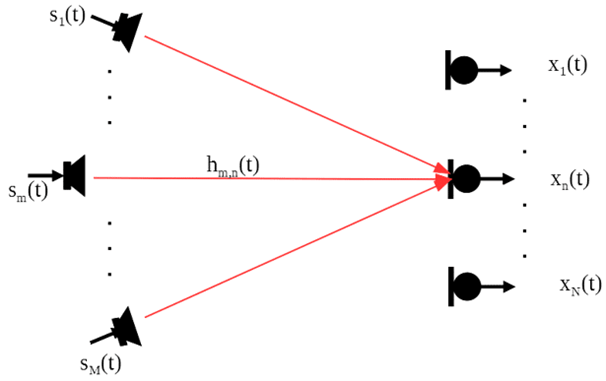
Adaptive Beamforming for Echo Cancellation
Abstract
Adaptive beamforming is a technique that significantly improves acoustic signal quality by dynamically directing sound while effectively minimizing echoes and reverberations. This white paper explores adaptive beamforming approaches specifically for echo cancellation, focusing on practical applications, performance assessment, and associated challenges. The paper categorizes adaptive beamforming methods into three key types: Linearly Constrained Minimum Variance (LCMV), Minimum Mean-Squared Error (MMSE), and Maximum-A-Posteriori (MAP). The analysis highlights the strengths, limitations, and contexts in which each method is most beneficial, particularly in environments prone to acoustic reflections. The concepts presented in this paper are based on established methodologies discussed in the literature.1
Introduction
Echo cancellation is vital in audio processing systems where sound reflections can degrade signal clarity. This challenge is particularly relevant in applications such as teleconferencing systems, hands-free communication devices, and immersive audio environments. Adaptive beamforming provides an effective strategy by isolating direct sound sources while reducing echoes, thereby maintaining high audio fidelity and minimizing feedback.
In practical audio systems, an acoustic human/machine interface typically features multiple loudspeakers (M) and a microphone array (N). To better visualize this configuration, Figure 1 presents a standard microphone array setup, illustrating how each microphone captures a blend of signals from various sound sources through their corresponding acoustic impulse responses. The notation {m, n} is used to denote the impulse response path from source m to microphone n.
The primary goal of the microphone array is to capture the intended speech signal while mitigating interference from other sound sources, such as ambient noise or other human talkers. This introduces two main challenges: acoustic echo cancellation across multiple reproduction channels and noise suppression using microphone arrays. Adaptive beamforming effectively addresses these challenges by focusing on direct sound while substantially reducing unwanted noise and echoes, leading to clearer audio and reduced feedback.

Addressing Limitations of Single-Channel Noise Reduction in Echo Cancellation
Conventional single-channel noise reduction techniques often struggle when dealing with interference and noise that have rapidly fluctuating spectral properties. To overcome these limitations, microphone array beamforming emerges as a powerful solution for diverse applications. By utilizing spatial information, beamforming enhances the separation of desired signals from unwanted disturbances. Adaptive, data-driven beamforming algorithms are particularly beneficial in dynamic environments where sound sources and their characteristics continuously change, as opposed to fixed, data-independent beamformers.
Classification of Adaptive Beamforming Methods
Adaptive beamforming strategies for speech and audio processing can be organized into three primary frameworks:
- Linearly Constrained Minimum Variance (LCMV) Beamforming
- Minimum Mean-Squared Error (MMSE) Beamforming
- Maximum-A-Posteriori (MAP) Beamforming
These methods do not include specialized techniques integrated with automatic speech recognition systems, which constitute distinct hybrid approaches.
LCMV Beamforming
Principles, Challenges, and Enhancements Core Concept and Implementation:
The LCMV beamforming technique, commonly realized through the Generalized Sidelobe Canceller (GSC) framework, functions by minimizing output signal variance while maintaining constraints that preserve the desired signal. A significant benefit of this approach is its capacity to suppress signals with rapidly changing spectral characteristics, like speech, without necessitating explicit computation of auto-power spectral densities (PSDs) or cross-power spectral densities (CPSDs) related to interference and noise at the sensors. Adaptive differential microphone arrays exemplify a specific application of LCMV principles.
Challenges in Real-World Scenarios:
Despite its advantages, LCMV beamforming encounters practical challenges in non-ideal acoustic settings, such as:
- Reverberation related to the intended signal
- Movement of sound sources
- Array imperfections, including microphone positioning errors or discrepancies in gain/phase
These factors may cause signal leakage, leading to undesired distortion. Possible mitigation measures include:
- Selective coefficient updates during interference dominance
- Optimization using constraint-based methods, like quadratic or adaptive spatio-temporal constraints
- Direct speech distortion control through targeted algorithms
Addressing Spatial Limitations:
The suppression of ambient noise and complex multi-source interference (such as in cocktail-party scenarios) is restricted by the microphone array’s spatial resolution. To overcome these constraints, hybrid methods have been developed:
- Combining LCMV beamforming with single-channel noise reduction to retain LCMV’s spatial filtering advantages while achieving noise reduction similar to MMSE techniques.
- Integrating GSC-based spatial processors with single-channel noise suppression or speech distortion-weighted multichannel Wiener filters to enhance overall noise reduction.
MMSE Beamforming
Characteristics and Practical Considerations:
MMSE beamforming extends the principles of single-channel noise reduction to multichannel contexts, incorporating spatial data from multiple sensors to enhance noise suppression. Unlike LCMV beamforming, MMSE techniques inherently resist the effects of array imperfections and environmental reverberation, thereby minimizing signal leakage. However, the inherent trade-off lies in the potential for signal distortion, particularly problematic in applications demanding high-quality speech reproduction.
MAP Beamforming
Statistical Flexibility and Simplified Estimation:
MAP beamforming serves as a computationally efficient alternative to complex MMSE estimators. It allows for more straightforward analysis by employing generalized statistical models, including super-Gaussian distributions to better characterize both speech and noise components.
Conclusion
Adaptive beamforming is indispensable for effective echo cancellation in audio systems, particularly in reflective environments. By comparing LCMV, MMSE, and MAP beamforming methods, this paper demonstrates that each technique offers specific benefits, from robustness against reverberation to enhanced computational efficiency. The methods discussed are rooted in established research and litreture1. Future white papers may focus on hybrid methodologies that integrate the strengths of each framework to optimize performance in diverse acoustic settings.
References
- G. S. berhard Hänsler, Topics in Acoustic Echo and Noise Control: Selected Methods for the Cancellation of Acoustical Echoes, the Reduction of Background Noise, and Speech Processing, (2006).